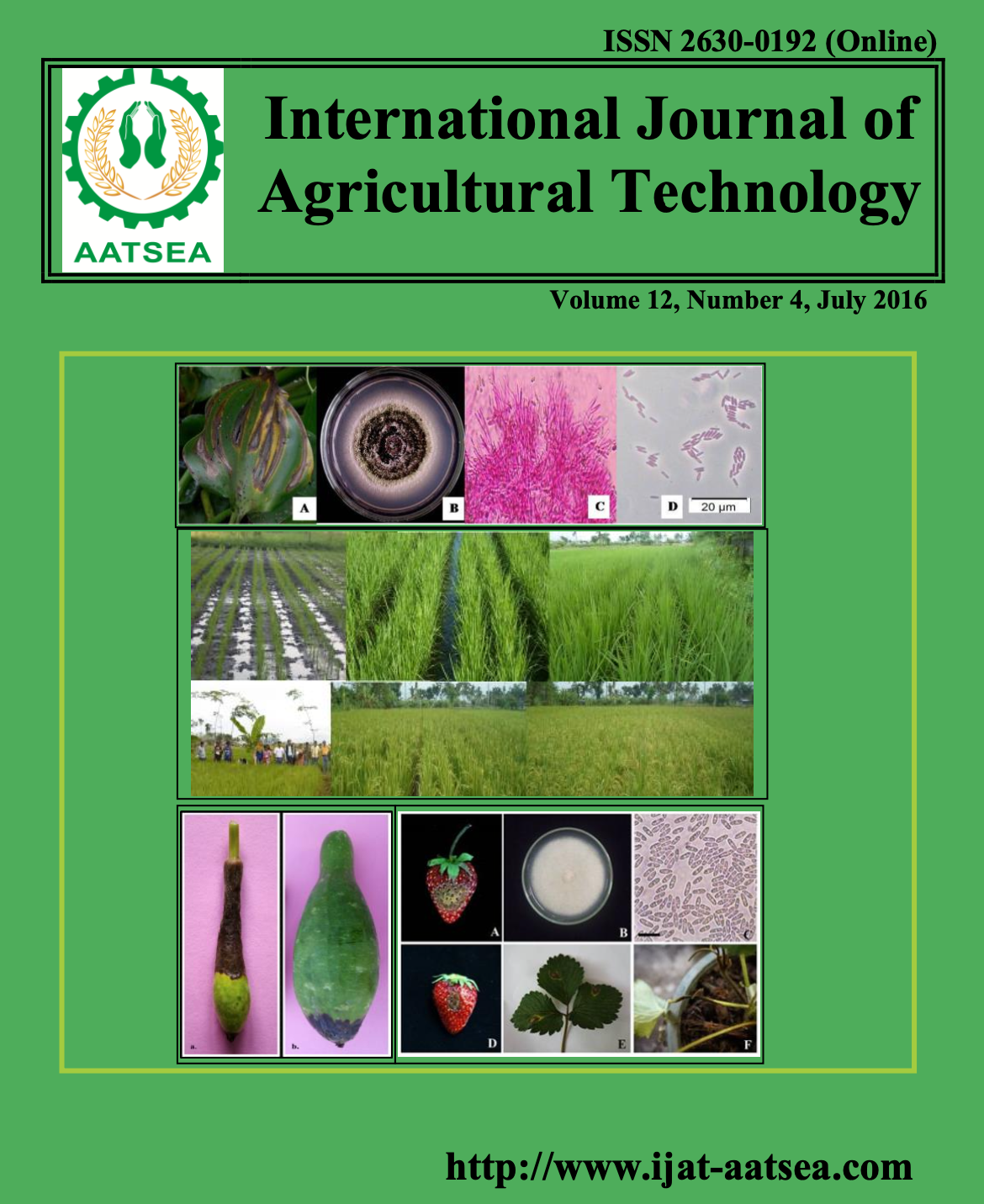Evaluation of selected seed treatment methods for the control of fusarium graminearum and f. Avenaceum on wheat seeds
Main Article Content
Abstract
Seed-borne diseases cause serious yield in cereal crop production in Lesotho, especially under small-holder farming systems. The main aim of the sudy was to determine the occurrence of both F. graminearum and F. avenaceum from different areas in Lesotho and evaluate the effect of various control measures on pathogen growth in vitro and disease incidence under green house conditions. Both F. graminearum and F. avenaceum were present in all four wheat cultivars irrespective of their area of collection. Various control measures were applied to determine their efficacy in suppressing pathogen growth in vitro, effect on seed germination and disease incidence under greenhouse conditions. The three tested plant extracts and Thiram significantly reduced mycelial growth of both pathogens and showed no negative effect on seed germination with Thiram exhibiting 100% pathogen growth inhibition. Hot water treatment of farm saved wheat seeds also resulted in an increased number of germinated seeds and reduced number of diseased wheat seedlings when compared with control. The lowest germination percentage was recorded in non-treated seeds where only 5.3% Eland seeds germinated. Results obtained in this study show that the three tested plant extracts and hot water treatement can be used to control wheat seed infestation by the two Fusarium spp and improve seed germination.
Article Details

This work is licensed under a Creative Commons Attribution-NonCommercial-NoDerivatives 4.0 International License.
References
Aggarwal, R., Srinivas, P., Srivastava, K. D. and Singh, D. V. (2008). Soil borne diseases of wheat and their management. In: Naik, Rani D (eds) Advances in soil borne plant diseases. New India Publishing Agency. New Delhi. pp. 165-217.
Arya, A. and Perelló, A. (2010). Management of fungal plant pathogens. CABI. United Kingdom. 400pp.
Bishaw, Z. (2004). Wheat and barley seed systems in Ethiopia and Syria. Ph.D Thesis, Wageningen University, Wageningen, the Netherlands 383p.
Brown, D. W., McCormick, S. P., Alexander, N. J., Proctor, R. H. and Desjardins, A. E. (2001). A genetic and biochemical approach to study trichothecene diversity in fusarium sporotrichioides and fusarium graminearum. Fungal Genetetics and Biology 32:121-133.
Cummings, J. A., Miles, C. A. and du Toit, L. J. (2009). Greenhouse evaluation of seed and trench treatements for organic management of soilborne pathogens of spinach. Plant Disease 93:1281-1292.
Dipali, M., Thangaswamy, R., Suting, E. G. and Ajit, D. (2013). Detection of seed borne pathogens in wheat: recent trends. Australian Journal of Crop Science 7:500-507.
ISTA (1999). International rules for seed testing. Seed Science Technology 23:269.
ISTA (2009). International rules for seed testing. Annex to chapter 7 Seed health testing. Seed health testing methods. International seed health testing association. Bassersdorf, Swizerland.
Koch, E., Schmitt, A., Stephan, D., Kromphardt, C., Jahn, M., Krauthausen, H. J., Forsberg G, Werner, S., Amein, T., Wright, S. A. I., Tinivella, F., Gullino, M. L., Roberts, S. J., van der Wolf, J. and Groot, S. P. C. (2010). Evaluation of non-chemical seed treatment methods for the control alternaria dauci and a. Radicina on carrot seeds. European Journal of Plant Pathology 127:99-112.
Kumar, A., Singh, U. S., Kumar, J. and Garg, G. K. (2008). Application of molecular and immune diagnostic tools for detection, surveillance and quarantine regulation of Karnal bunt (Tilleteia indica) of wheat. Food and Agricultural Immunology 19:293-311.
Mann, A., Banso, A. and Clifford, L. C. (2008). Antimicrobial properties of crude plant extracts from anogeissus leiocarpus and terminalia avicennioides. Tanzania Journal of Health Research 10:34-38.
Masum, M. M., Islam, S. M. M. and Fakir, M. G. A. (2009). Effect of seed treatment practices in controlling of seed-borne fungi in sorghum. Scientific Research and Essays 4:22-27.
Perelló, A., Gruhlke, A. and Slusarenko, A. J. (2013). Effect of garlic extract on seed germination, seedling health and vigor of pathogen infested wheat. Journal of Plant Protection Research 53:317-323.
Parry, D. W., Jenkinson, P. and Mc Leod, L. (1995). Fusarium ear blight (scab) in small-grain cereals-a review. Plant Pathology 44:207-238.
Rhouma, A., Ben Daoud, H., Ghanmi, S., ben Salah, H., Romdhane, M. and Demak, M. (2009). Antimicrobial activities of leaf extracts of pistacia and schinus species against some plant pathogenic fungi and bacteria. Journal of Plant Pathology 91:339-345.
Rosenblum, M. L., Tsiu, J. and Moletsane, M. (1999). Farmer wheat (triticum aestivum) varieties in the highlands of lesotho. In: Participation and partnerships in extension and rural development. Proceedings of the 33rd Annual Conference of the Society for Agricultural Extension, 11-13 May, 1999, Bloemfontein, South Africa.
Rudd, J. C., Horsley, R. D., McKendry, A. L. and Elias, E. M. (2001). Host plant resistance genes for Fusarium head blight: sources, mechanisms, and utility in conventional breeding systems. Crop Science 41:620-627.
Tinivella, F., Hirata, L. M., Celan, M. A., Wright, S. A. I. and Schmitt, A. (2009). Control of seedborne pathogens on legumes by microbial and other alternative seed treatments. European Journal of Plant Pathology 123:139-151.
Yassin, M. A., Moslem, M. A. and El-Samawaty, A. (2012). Mycotoxins and non-fungicidal control of corn grain rotting fungi. Journal of Plant Science 7:96-104.


